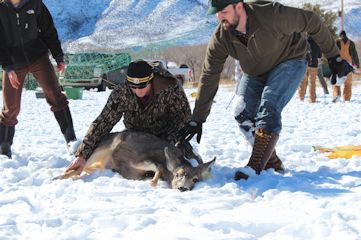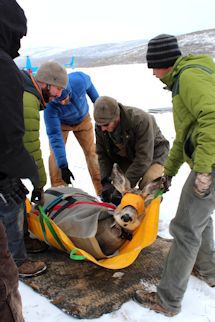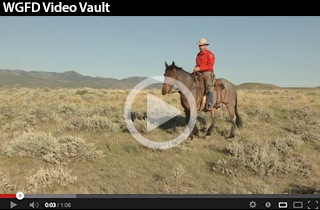Two Research Projects Ongoing: Baggs and Wyoming Range Mule Deer Herds
Wyoming Game & Fish Department sent this bulletin at 12/17/2013 10:49 AM MST 
|
|
Having trouble viewing this email? View it as a Web page. |
RESEARCHERS MONITOR MULE DEER IN TWO SW WYOMING HERDS
GREEN RIVER—Wyoming Game and Fish Department personnel, researchers with the Wyoming Cooperative Fish and Wildlife Research Unit at the University of Wyoming, personnel from the Bureau of Land Management and US Forest Service, and many volunteers are trapping mule deer for two research projects in southwest Wyoming to learn more about the ‘icon of the West’.
Research projects continue in the Baggs and Wyoming Range mule deer herds. The Baggs mule deer herd is comprised of hunt area 82. The Wyoming Range mule deer herd is one of the largest herd units in Wyoming, comprised of deer hunt areas 134, 135, 143, 144, and 145. The data collected from these projects will help wildlife managers better manage these deer herds.
Mule deer trapping operations in the Baggs herd began in 2011 and will continue into 2014. Mule deer are baited two weeks before trapping. Apple pulp is used as the bait and the mule deer can’t resist it. The trapping team uses a 40’ X 40’ square net made by Wildlife Capture based out of Flagstaff, Arizona. The net is hung from five poles, one in each corner and one in the center. Biologists hide in a photography blind in front of the trapping site and wait for the deer to come underneath the drop net to feed on the apple pulp. When the deer are busy feeding, the release button is activated and the electro-magnetic-operated net falls on top of them.
Bright yellow numbered ear tags and white vinyl visual collars are placed on all deer captured to determine annual survival of deer using the Baggs underpasses via mark-resight methods. Some bucks are fitted with VHF ear tags donated to the Game and Fish from Colorado Parks and Wildlife. Now in its third year, the trapping project has yielded valuable data that will assist wildlife managers in Wyoming and Colorado.
“We know there is interchange between the deer here in Baggs and our neighbors to the south, Colorado,” said Baggs Wildlife Biologist Tony Mong. “We have been able to share data with Colorado Parks and Wildlife through the use of VHF ear tags we are placing on buck mule deer. Since buck ratios are an important parameter of our population management techniques it is very important to find out where our bucks are going so that we don’t included them in our population estimates if they are Colorado mule deer and vice versa.”
Mong spends many long hours looking at the underpass trail camera footage looking for the deer with ear tags or collars. He then records the date and time the deer went through the underpass, as well as the direction they are traveling. Mong encourages people to report any mule deer they see with a yellow ear tag or a white visual collar. These reports are critical to collecting accurate data of where these deer migrate to and when.
Mule deer capturing operations in the Wyoming Range herd began in March 2013. Thirty-five doe deer were captured on the Labarge/Big Piney winter range complex and 35 more were captured on winter ranges between Kemmerer and Evanston. These deer were recaptured December 13-15 and the data from their collars was downloaded. There has been substantial debate regarding whether or not the population objective for the WRMDH is still feasible under current conditions. This research project will allow biologists to focus on where this mule deer population is now relative to current habitat conditions and find ways we can help mule deer populations recover to desired levels.
Unlike the Baggs operation, a helicopter and crew of “muggers” from Native Range Capture Company located the deer and used a net gun to capture them. Then the deer were transported by helicopter to a processing station. The data was downloaded from each GPS collar. Biologists determined the age of the deer and their body fat was measured. An ultrasound was conducted to check their pregnancy and fetal status and a blood and fecal sample was taken before the deer were released.
Numerous groups have partnered with us to make this mule deer study happen. Key contributors include the Wyoming Game and Fish Department, the Rock Springs Chapter of Muley Fanatics Foundation, Bureau of Land Management, Wyoming Governor’s Big Game License Coalition, Animal Damage Management Board, Bowhunters of Wyoming, Sportsmen for Fish and Wildlife, and the Wyoming Outfitters and Guides Association.
~WGFD~
Photo Credit: Lucy Wold, WGFD
 Baggs mule deer
Baggs mule deer
 Wyoming Range mule deer
Wyoming Range mule deer
Contact: Mark Zornes 307-875-3223 or Tony Mong 307-380-8283


